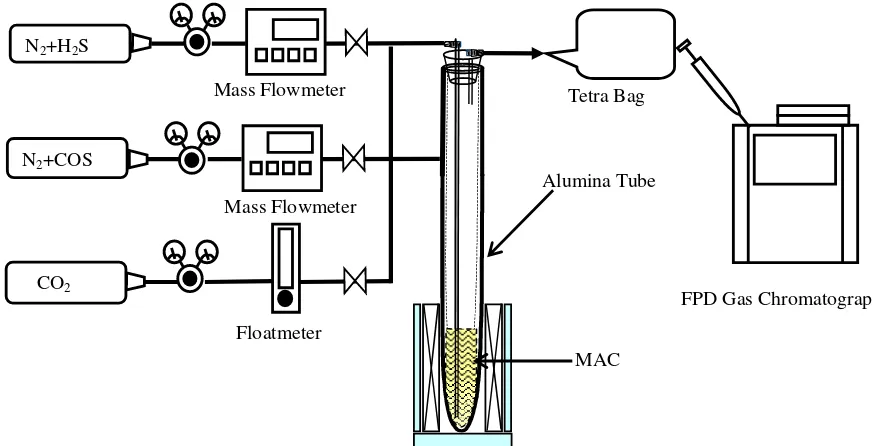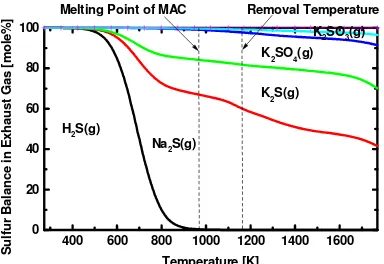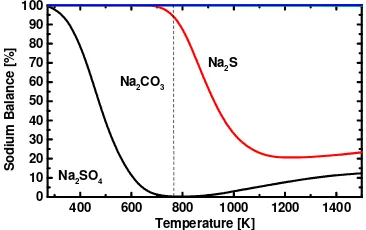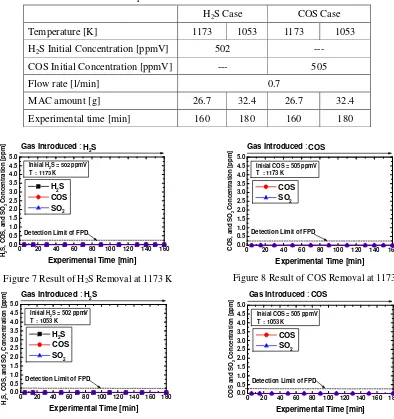Desulfurization Characteristic by Molten Alkali Carbonates at
High Temperature
S. Raharjo1 and I. Naruse2
1
Department of Ecological Engineering
2
International Cooperation Center for Engineering Education Development (ICCEED) Toyohashi University of Technology, Tempaku-cho, Toyohashi 441-8580, JAPAN
Contact Person: Slamet Raharjo
Department of Ecological Engineering
Toyohashi University of Technology, Tempaku-cho, Toyohashi 441-8580, JAPAN E-mail: slamet_281983@yahoo.com
Abstract
In order to remove H2S and COS in the gasified gas, produced by coal gasifires (e.g. IGFC) at high
temperature, molten alkali carbonates (MAC) consisting of Na2CO3 and K2CO3 were applied as
solvent. Before the removal experiments, the optimum experimental conditions were estimated in terms of the chemical equilibrium calculations. After that, the removal experiments of H2S and/or
COS by the molten alkali carbonates were conducted in alumina tube furnace, varying the furnace temperature. As a result, H2S and COS were completely removed by the molten alkali carbonates.
The concentrations of both H2S and COS in the clean-up gas became less than the detection limit
of FPD gas chromatograph. Additionally, the regeneration tests at high temperature of used MAC following the removal tests were conducted by introducing CO2 as a regeneration agent into the
reaction tube to form Na2CO3 and K2CO3. The regeneration tests for Na2S and K2S in solid phase
in the CO2 atmosphere, using a thermo-gravimetric analyzer, were also carried out. Under the
present experimental conditions, it was hard to regenerate the used MAC.
Keywords:Gas clean-up, Desulfurization, Gasified gas, Molten alkali carbonate
1 INTRODUCTION
Coal gasification has been recognized as one of clean and effective technologies to produce CO
and H2, which can be used for power plant, heat generation or as a synthesis precursor [1]
. In the
field of power generation for electricity, particularly, coal gasification will play a role for a
future promising technology since it can improve the net thermal efficiency and decrease CO2
emission all at once.
When the coals with high sulfur content are gasified, however, H2S and COS are contained in
the gasified gas. If the gasified gas is directly used as the fuel for fuel cells or synthesis gas (H2
and CO) for chemical materials, H2S and COS may affect subsequent processes of the gasifier.
Therefore, H2S and COS in the gasified gas should be removed almost completely [2]
. In the
application of coal gasification integrated with fuel cell, more strictly removal of H2S and COS
is needed due to their poisonous effect to the anode of fuel cell. Currently, clean coal technology
is a main issue in the field of power generation technology in the world. Japanese government is
now developing an important project named coal Energy Application for Gas, Liquid, and
Electricity (EAGLE). This system combines fuel cell (FC) with generation turbine (GT) and
steam turbine (ST), which is called triple combined cycle. This triple combined cycle improves
net efficiency over 53% and reduces CO2 emission 30%, compared to pulverize coal-fired
boilers (PCF)[3].
This EAGLE system needs to install cold gas cleanup system in order to satisfy the tolerance
limits of fuel cell. Therefore, the synthesis gas must be heat-exchanged at the gas/gas heater
(GGH). The cooled down gas is, then, desulfurized in a Methyldiethanolamine (MDEA)
absorber. The clean synthesis gas, which exits the MDEA absorber at approximately 313 K, is
heated to approximately 473 K by a steam heater and GGH, and is supplied to the gas turbine.
Although the cold gas cleanup system is currently applied, the hot desulphurization system
favors to increase the net thermal efficiencies[4]. Because removing sulfur compounds at high
temperature can result in a gain of 6 % in the overall efficiency for a typical power generation
system[5, 6]. Therefore, it is necessary to develop the suitable desulfurization technologies at high
temperature.
The development of reliable methods to remove sulfur compounds in the coal gasified gases at
high temperatures, instead of practical wet scrubbing techniques that operate at around 323 K, is
one of the important technological advances. Therefore, this study proposes one of the removal
technologies of H2S and COS in the gasified gas at high temperature, using molten alkali
carbonates (MAC), consisting of Na2CO3 and K2CO3 as solvent.
2 EXPERIMENTAL CONDITIONS AND PROCEDURES
Before the removal and regeneration experiments, the optimum experimental conditions were
analyzed in term of chemical equilibrium calculation. After that, the removal experiments of
H2S, COS and their mixed gas (H2S+COS) by the molten alkali carbonates are conducted.
inside diameter and 500 mm length, made from alumina. Molten alkali carbonates with
composition of 43 mol%-Na2CO3 and 57 mol%-K2CO3 inserted into the furnace is electrically
heated at a designed temperature. H2S and COS gas are introduced into the furnace. The product
gas is introduced into an FPD gas chromatograph to analyze H2S, COS and SO2 concentrations.
Following the removal tests, the regeneration tests are conducted by changing introduced gas
from sulfuric gas to CO2 as the regeneration agent. In order to investigate regeneration
characteristic of Na2S and K2S in solid phase in the CO2 atmosphere, regeneration tests by using
a thermo-gravimetric analyzer are carried out.
3 RESULTS AND DISCUSSIONS
3.1. Chemical Equilibrium Calculations
The chemical equilibrium calculations were conducted by using chemical reaction and
equilibrium software with extensive thermochemical database[7]. The initial conditions for
chemical equilibrium calculation for H2S and/or COS removal process are shown in Table 1.
FPD Gas Chromatograph Tetra Bag
Mass Flowmeter
N2+COS N2+H2S
Alumina Tube Mass Flowmeter
Floatmeter CO2
MAC
Table 1 Initial Conditions for H2S and/or COS Removal Process Simulations
Figures 2, 3, and 4 show the results of chemical equilibrium calculation of removal process of
H2S, COS and their mixture, respectively. These results suggest that, even at high temperature,
the concentration of gaseous sulfur compounds would be zero. Based on this calculation, the
removal temperature was determined as 1173 K. Figures 2, 3, and 4 also suggest that the main
products of removal process are Na2S and K2S.
In order to know the simulation characteristic of Na2S and K2S regenerations, their chemical
equilibrium calculations were also carried out. Table 2 shows the initial conditions for Na2S and
K2S regeneration simulations. Figures 5 and 6 show results of chemical equilibrium calculation
of regeneration process for Na2S and K2S, respectively. In this calculation CO2 is introduced as
the regeneration agent. These results show that Na2S and K2S mainly convert to M2CO3 at 773
K (M: Na or K).
Figure 2 Chemical Equilibrium Calculation of H2S Removal
Figure 3 Chemical Equilibrium Calculation of COS Removal
400 600 800 1000 1200 1400 1600 0
Melting Point of MAC
S 400 600 800 1000 1200 1400 1600
0
Melting Point of MAC
Table 2 Initial Conditions for Na2S and K2S Regeneration Simulations
3.2 Removal Tests
Table 3 shows the initial conditions for H2S and/or COS removal tests. Figures 7, 8, 9 and 10
show result of H2S, COS and SO2 concentrations in the product during the H2S and COS
removal tests at 1173 K and 1053 K, respectively. From these figures, H2S, COS and SO2
concentrations detected become smaller than the detection limit of FPD gas chromatograph.
Consequently, sulfur species are completely captured by the MAC to form Na2S and K2S mainly.
Based on the experimental and chemical equilibrium calculations, the following reactions could
be occurred in this removal process (l: liquid, g: gas, c: condensed).
Figure 4 Chemical Equilibrium Calculation of Mixed Gases (H2S+COS) Removal
Figure 5 Chemical Equilibrium Calculation of Na2S Regeneration
Figure 6 Chemical Equilibrium Calculation of K2S Regeneration
400 600 800 1000 1200 1400 1600 0
Melting Point of MAC
S
400 600 800 1000 1200 1400
0
400 600 800 1000 1200 1400
M2CO3(l) + H2S(g) M2S(c) + H2O(g) + CO2(g)
M2CO3(l)+ COS(g) M2S(c) + 2CO2(g)
Table 3 Experimental Conditions for Removal Tests
H2S Case COS Case
Temperature [K] 1173 1053 1173 1053
H2S Initial Concentration [ppmV] 502 ---
COS Initial Concentration [ppmV] --- 505
Flow rate [l/min] 0.7
MAC amount [g] 26.7 32.4 26.7 32.4
Experimental time [min] 160 180 160 180
3.3 Regeneration tests
Figures 11 and 12 show results of the regeneration test after the H2S and COS removal tests at
1173 K, respectively. When the reactant is changed to CO2 with the flow rate of 1 l/min, only a
small amount of COS is produced. It means that the regeneration process will be hardly
performed at high temperature.
0 20 40 60 80 100 120 140 160
Detection Limit of FPD Initial H2S = 502 ppmV
Detection Limit of FPD Initial COS = 505 ppmV T : 1173 K
Gas Introduced :COS
C
Figure 7 Result of H2S Removal at 1173 K Figure 8 Result of COS Removal at 1173 K
Figure 9 Result of H2S Removal at 1053 K
Detection Limit of FPD Initial H2S = 502 ppmV
Detection Limit of FPD Initial COS = 505 ppmV T : 1053 K
Gas Introduced :COS
C
According to the equilibrium calculation result of Figs. 5 and 6, the optimum regeneration
temperature seems to be 773 K. Therefore, the regeneration tests for Na2S and K2S are
conducted in the CO2 atmosphere by the thermo-gravimetric analyzer. Figures 13 and 14 show
results of the regeneration tests at 773 K for Na2S and K2S, respectively. Comparing both the
figures, Na2S can be regenerated more easily by CO2 than K2S. During this regeneration test, a
few ppm of COS gas was detected in the product gas. However, the sulfur balance was not
sufficient. Therefore, the following reactions would occur during the regeneration.
M2S(s) + CO2(g) M2CO3(s) + COS(g)
M2S(s) + CO2(g) M2SO4(s) + others
190 200 210 220 230
0.0
After COS = 505 ppmV Removal T : 1173 K
Regeneration Agent :
C
190 200 210 220 230 240 250
0.0
Regeneration Agent :
C
Figure 11 Result of Used MAC Regeneration Test following H2S Removal
Figure 12 Result of Used MAC Regeneration Test following COS Removal
0 5 10 15 20 25 30 35 40 45 50 55 60 65 70
Na2S initial weight : 14.100 mg
Holding Temperature : 773 K
CO2 N2
Moisture Weight ChangingProfile
Temperature Profile Holding Temperature : 773 K
CO2
N2
K2S Vaporization
Moisture Regeneration in CO2
4 CONCLUSIONS
Desulfurization characteristics by molten alkali carbonates (MAC) were studied experimentally,
using alumina tube furnace. Chemical equilibrium calculations were carried out prior to the H2S
and/or COS removal experiments. Additionally, regeneration tests of used MAC were also
carried out. The main results obtained are summarized below.
1. Chemical equilibrium calculations for H2S and/or COS removal process show that, even at
high temperature, the concentration of gaseous sulfur compounds become zero.
2. Molten alkali carbonates (MAC) can be applied as a liquid solvent to capture gaseous sulfur
compounds in the gasified gas even at high temperature. The following reactions could be
occurred in this removal process (l: liquid, g: gas, c: condensed):
M2CO3(l) + H2S(g) M2S(c) + H2O(g) + CO2(g)
M2CO3(l)+ COS(g) M2S(c) + 2CO2(g)
3. The regeneration of the used MAC is difficult under the present experimental conditions.
REFERENCES
1) Saito, I.(2003), 20th Annual International Pittsburgh Coal Conference Sept. 15 – 19. 2) Mitchell, S. C.(1998), IEA Coal Research the Clean Coal Center.
3) EAGLE. (2006). Multi Purpose Coal Gasification Technology Development. NEDO and J-Power.
4) Henderson, C.(2004). IEA Clean Coal Center, ISBN 92-9029-406-X.
5) Furimsky, E., Yumura, M. (1986). Solid Adsorbents for Removal of Hydrogen Sulfide from
Hot Gas. Erdol und Kohle-Erdgas-Petrochemie, 39(4). Pp. 163-172.
6) Barthelemy, N.M. (1991). Improved Heat Recovery and High-Temperature Clean-up for Coal-gas Fired Combustion Turbines. Master of Science Thesis, Department of Chemical Engineering, University of California at Barkeley.




